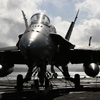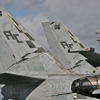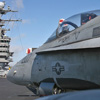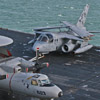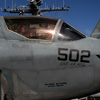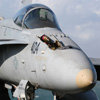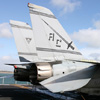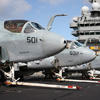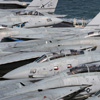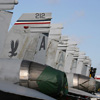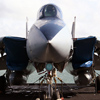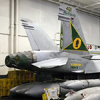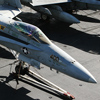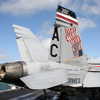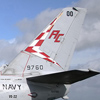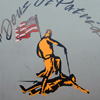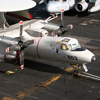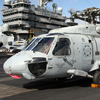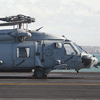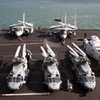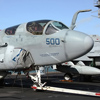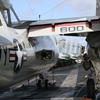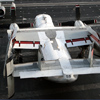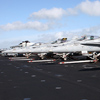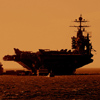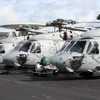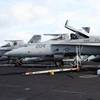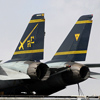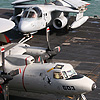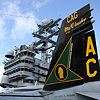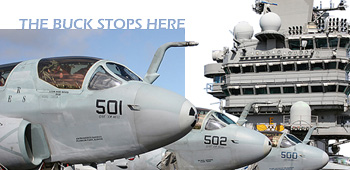
USS Harry S. Truman Feature Report
April
United States Navy aircraft carrier is an imposing sight for anybody who sees one for the first time. As the major component of a naval strike group, the aircraft carrier can be deployed anywhere in the world and, when called upon in a time of conflict, its air wing component provides a sizeable strike force for tactical and strategic attacks. During peacetime it provides a credible, sustainable, conventional deterrence and independent forward presence. When the aircraft carrier makes a good-will port visit in any country, it's arrival generates considerable interest.
and found their sea-legs and took a short boat trip to see what was onboard the USS Harry S. Truman (CVN-75), additional photography from .
The USS Harry S. Truman (CVN-75) made a very welcome UK port visit in early April 2005 when it arrived on a grey, misty morning and dropped one of its 30 ton anchors in Stokes Bay, near Portsmouth. The 97,000 tons aircraft carrier has been at sea for the past six months and, after completing operations in the Persian Gulf on 19 March in support of "Operation Iraqi Freedom" (OIF) and Maritime Support Operations (MSO), is heading homeward back to Norfolk Naval Base, Virginia. The carrier had made port visits at various locations in the Middle East and the UK visit provided the crew and Marines with some well earned and needed shore leave before they returned to the States. Whilst in UK waters a change-of-command ceremony took place on April 8 when Rear Admiral. Joseph F. Kilkenny relieved Rear Admiral. Michael C. Tracy as Commander, Carrier Strike Group 10.
Embarked onboard the Truman is Carrier Air Wing 3 (CVW-3). This air wing comprises seven US Navy squadrons and one US Marine Corps squadron which give a combined total of approximately 80 aircraft as follows:
- VF-32 "Swordsmen" F-14B
- VFA-37 "Bulls" F/A-18C
- VFA-105 "Gunslingers" F/A-18C
- VAW-126 "Seahawks" E-2C
- VAQ-130 "Zappers" EA-6B
- VS-22 "Checkmates" S-3B
- HS-7 "Dusty Dogs" SH-60F/HH-60H
- VMFA-115 "Silver Eagles" F/A-18A+
The US Marine Corps squadrons are now integral parts of each carrier air wing and are regularly embarked on the aircraft carriers where they play a vital operational role alongside their Navy counterparts. Also onboard are two C-2A Greyhound aircraft of VRC-40 "Rawhides" det.5 which provide Carrier Onboard Delivery (COD) duties. These aircraft will fly to and from shore bases to drop off or collect personnel and ships supplies to replenish the carrier. For many years the majority of Navy fighter/strike aircraft have been painted in a low-vis grey scheme with toned down unit markings, so it was a pleasure to see some of the CVW-3 aircraft painted in high-colour schemes, each unit having at least one aircraft painted as such.
The Grumman F-14B Tomcats of Fighter Squadron 32 (VF-32) "Swordsmen" are on their final cruise with this aircraft type, the squadron having flown their final combat missions with their Tomcats in the skies over Iraq. Each aircraft in the squadron has received noseart which depicts a "Swordsman" and the inscription "Deus et Patria" - "God and Fatherland" and also artwork below the flightcrew's canopy with the inscription "Final Gypsy Roll - 32 years of Tomcats". The squadron will return to NAS Oceana where they will begin transition to the Boeing F/A-18F Super Hornet but some Tomcats are expected to still be with the squadron at the NAS Oceana air show in September this year.
Truman facts:
| Length of Flight Deck | 1,096 feet (as long as the Empire State Building is tall) |
| Height, Waterline to Masts | 20 stories |
| Width of Flight Deck | 251 feet at its widest point |
| Area of Flight Deck | 4.5 acres |
| Water Displacement | 97,000 tons |
| Propulsion | 2 nuclear reactors |
| Number of Screws | 4 (5 blades each, 21 feet across) |
| Weight of Screws | 66,200 pounds each |
| Top Speed | Exceeds 30 knots |
| Number of Catapults | 4 |
| Number of Aircraft Elevators | 4 |
| Size of Air Wing | Eight squadrons and one detachment, with more than 80 aircraft |
| Homeport | Norfolk, Va |
| Crew Size | More than 5,200 with embarked air wing, more than 3,000 without air wing |
| Meals served daily | 18,150 |
| Number of compartments | 2,700 |
| Number of Anchors | 2, from USS Forrestal (CV 59) |
| Weight of Anchors | 30 tons each |
| Length of Anchor Chain | More than 1,000 feet, with 684 links each weighing 365 pounds each |
| Number of Telephones | 2,000 |
| Tactical Aircraft | F-14 Tomcats, F/A-18 Hornets, EA-6B Prowlers, S-3B Vikings, E-2C Hawkeyes, SH-60 Seahawks, C-2A Greyhounds |

